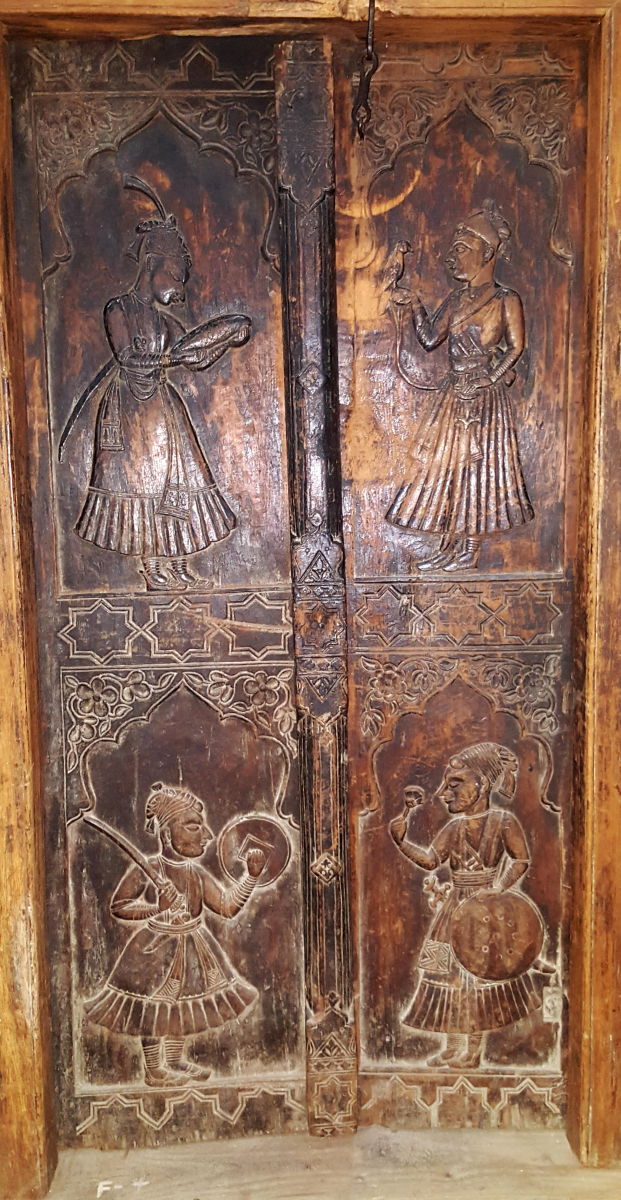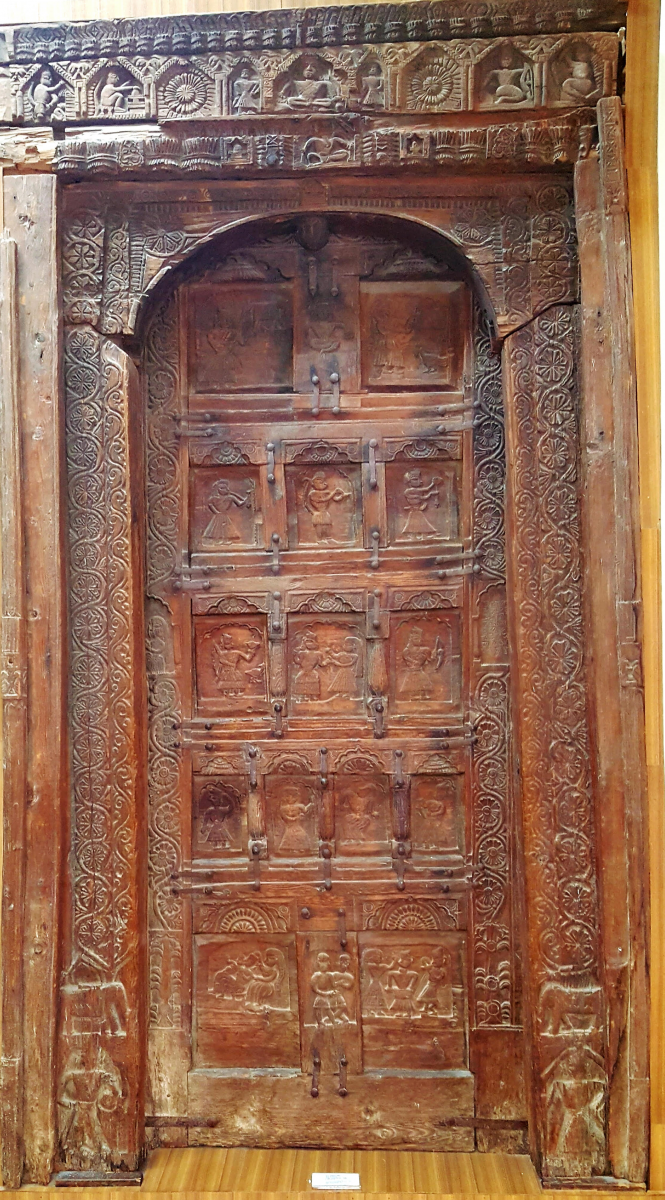In the hilly region of Chamba, which has extensive forests, wood is chiefly used for building, both in ordinary dwellings and in edifices of a more ornamental character, such as temples and shrines. In Bharmour, which is one of the five tehsils of the present Chamba district of Himachal Pradesh, we find the art of woodcarving extensively applied to secular and domestic architecture from as early as the seventh century. Bharmour (ancient name Brahmpura), the tribal belt, also had the distinction of being the capital of the state of Brahmpura for over four centuries (seventh to the tenth century CE), until the capital was shifted to the present Chamba town.
The tribal area of Bharmour tehsil is presently inhabited mostly by the Gaddis, who are semi-nomadic tribal people and migrate to the lower plains from October to March because of the scarcity of work and the severity of winter.[1] Most families have fixed shelters in the lower hills, where members of the nomadic tribe work as domestic servants. Several Gaddi families have permanently settled in the Rilhu, Palam and Baijnath areas in the Kangra district.
According to Dr Hermann Goetz, Chamba along with Pathankot and Hoshiarpur formed part of the Audumbara republic in the second century CE. The coins of the Audumbaras reveal wooden shrines on the obverse, which are in fact evidence of the earliest dedications to Shiva in any medium in India.
The tradition of woodcarving
Early wood-carved temples that survive in Bharmour and Chhattrari have close affinity in style to Gupta-period temples. Woodcarvings in the classical style are seen only in the temples of Lakshana Devi and Shakti Devi, in the villages of Bharmour and Chhattrari respectively. Both temples were built by Raja Meruvarman in about 700 CE. These temples are profusely embellished with woodcarvings showing a high degree of excellence, on the façade, ceilings and doorways with rows of figures of the deities of the Hindu pantheon. The capitals of the wooden pillars are superbly carved with the motifs of puranghat (pot and foliage) and panels of Kichakas (celestial beings), of which the central one is adorned with a full-blossomed lotus flower, reminder of the influence of the Gupta art.
The richness of the woodcraft tradition can be seen in many of the later carvings on temples, castles and houses in the tribal area of Bharmour. The carved doors, eaves, pillars, window frames, façades, panels, brackets and balconies of houses all speak of the fineness of the tradition in this particular area. Sometimes one notices different styles or techniques of carving, particularly in the temples, on account of the replacement of rotten or decayed architectural members. The village Ranuh-Kothi near the village Chhattrari is famous for wooden utensils. These splendid carvings speak of the continuity of the tradition of woodcarving as well as the mastery over the technique.
Usually the woods employed for both―the construction and the decorative carvings for the embellishment of the structure, are deodar (devadaru in Sanskrit), walnut, shisham, tun, kail and pine. However, deodar is profusely used by the artisans of the Bharmour area, due to the quality of high-relief cutting possible.
The State Kothi of Bharmour was once embellished with decorative carved panels and brackets. It suffered massive damage in an earthquake in April 1905. Most of the carved panels and brackets were taken to Chamba and are now preserved in the Bhuri Singh Museum, Chamba. The State Kothi was built at Chaurasi town, the headquarters of the Bharmour area, by Raja Prithvi Singh (r. 1641–1664) as one of the door panels depicts this Raja receiving honours from the Mughal Prince Dara Shukoh.

Fig. 1: Carved Door from State-Kothi, Bharmour, c. 1650 CE
The door panels exhibit figures of great interest. The State Kothi was designed as a royal residence as well as administrative centre. Inspired by Mughal art, the carvings on the door as well as decorative panels were executed in low relief on deodar planks. These magnificent carvings display figurative and decorative motifs borrowed from a provincial Mughal style of painting.
In the upper registers, young Prithvi Singh is shown holding a large fish in his hands. He was the only prince who visited the Mughal court nine times during Emperor Shah Jahan’s time, where he was sumptuously rewarded with precious gifts. In front of him stands a royal figure holding a falcon in his right hand. The falconer sporting a shahjahani turban and a jama tied in the Mughal fashion is in all likelihood Prince Dara Shukoh, the eldest son of Shah Jahan, with whom Raja Prithvi Singh had developed a deep friendship. The falcon held by the Mughal Prince must have been presented by Prithvi Singh, as falcons were greatly in demand from hill princes among the Mughals.
In the lower cartouches topped by cusped arches, two figures are again shown. The one standing at the right appears to be a royal personage, while the other, holding a sword and a shield, is a warrior. The cusped arches and the six-star motifs suggest a marked Mughal influence.
As mentioned above, the magnificent temples of Lakshana Devi in Bharmour and Shakti Devi at Chhattrari are richly embellished with the exquisite wooden art of the post Gupta period. These temples have been the source of inspiration for motifs and figurative designs among artisans of later eras.
In Bharmour and its surroundings, most of the houses are made of wood, some of them still possessing the carved decorative motifs in the folk style. Of special note is the village Swai (near Ulansa) near Bharmour, where the house of Rana, a local chieftain, was decorated with splendid folk wooden art. These carvings were engraved by Chhajju, a local artisan of the badhi caste, evident from the inscription incised on one of the wooden panels of the large door. An inscription in takri[2] incised on the large wooden entrance gate (parol; Sanskrit pratoli) from Swai, mentions the name of a Badhi Chhajju, who carved decorative and figurative motifs in folk style. This inscription is now preserved in the Bhuri Singh Museum, Chamba.

Fig. 2: A Magnificent Wooden Door from village Swai, Bharmour, 1877 CE, inscribed in takri on the right side. ‘The purport of the inscription is that the door was made by the carpenter Chhajju by the order of Rana Jahar in the year 53, i.e., 1877 CE. Present by Rana Chet Singh of Swai’ (Sharma 2008:182).
The remnants of the old mansion of the Rana are an excellent example of workmanship in folk woodcraft. The figurative carvings are truly folkish in treatment. The human and divine figures are typically folk and have nothing to do with the Pahari painting. The dresses worn by them are of the Gaddi tribal people. The men are shown clad in long woollen cholas (coat) tied with a dora (a long rope made of sheep’s wool) over the pyzama (loose-fitting trousers). Men are also shown wearing long woollen caps. Women are usually depicted doing daily household chores like combing hair, pounding rice with a long wooden pestle, playing with children, cooking food etc. Several panels display figurative compositions based on vivid realizations of the day-to-day life of tribal people of Bharmour region.
The carved panels are held together by iron joists. The doorway is interesting for its size as it is made of deodar wood. All three members, the lintel and the doorjambs, are carved out of three massive blocks of wood. There are no nails for the joints.
The horizontal lintel above the doorjamb is divided into three registers and rests on two plain and simple shakhas (vertical shafts). The uppermost section shows a series of double lotuses tied together with ribbons; above this is a running frieze of lotus petals. Below is a row of triangular niches, which shows a tiny devotee in the left looking up in awe at the large figure of Hanuman. The second figure shows a devotee sitting on a couch (chowki) and worshipping a Shivalingam on a pedestal with mouldings. The third niche has a full-blown lotus carved frontally in bold relief. The central figure depicts an ascetic seated cross-legged holding a rosary and kamandal (a water vessel) in his hands. He is flanked by two figures wearing jamas and holding swords. Next in the series of carvings is again a full-blossomed lotus, which is followed with a shara-chapadhara (an archer) with a bow and arrow in his hands. The last figure in the row is a squatting warrior holding a shield and sword. The third register in the lintel represents a series of lambrequin motifs interrupted by small lingams in the niches, which indicate Bharmour to be a Shivabhumi, a prominent centre of Shaivism.
References
Sharma, Vijay and S.M. Sethi. 2008. Vision of an Enlightened King: A Centennial Bouquet of Himalayan Art from the Bhuri Singh Museum Collection. Shimla: Dept. of Language & Culture, Chamba: Bhuri Singh Museum, Himachal Pradesh.
[1] The migration of Gaddis to the lower plains is considerably reduced because of the development of the area and the facilities provided here by the Government.
[2] The Takri script derives from the Sarada script and was used in the western regions of the Himalayas. By the early 20th century, it was replaced by Devanagari.












